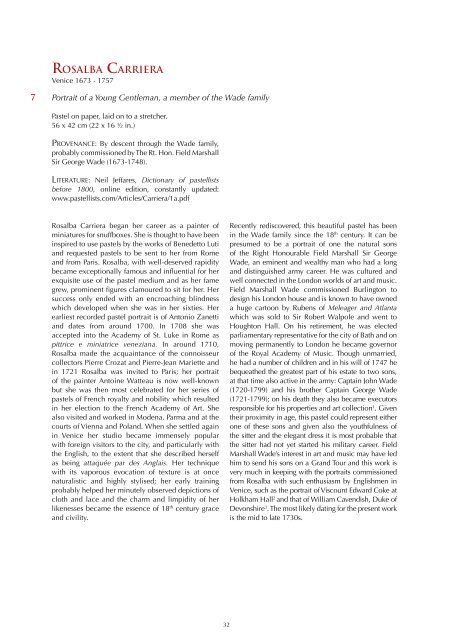You also want an ePaper? Increase the reach of your titles
YUMPU automatically turns print PDFs into web optimized ePapers that Google loves.
Rosalba Carriera<br />
Venice 1673 - 1757<br />
7<br />
Portrait of a Young Gentleman, a member of the Wade family<br />
Pastel on paper, laid on to a stretcher.<br />
56 x 42 cm (22 x 16 ½ in.)<br />
Provenance: By descent through the Wade family,<br />
probably commissioned by The Rt. Hon. Field Marshall<br />
Sir George Wade (1673-1748).<br />
Literature: Neil Jeffares, Dictionary of pastellists<br />
before 1800, online edition, constantly updated:<br />
www.pastellists.com/Articles/Carriera/1a.pdf<br />
Rosalba Carriera began her career as a painter of<br />
miniatures for snuffboxes. She is thought to have been<br />
inspired to use pastels by the works of Benedetto Luti<br />
and requested pastels to be sent to her from Rome<br />
and from Paris. Rosalba, with well-deserved rapidity<br />
became exceptionally famous and influential for her<br />
exquisite use of the pastel medium and as her fame<br />
grew, prominent figures clamoured to sit for her. Her<br />
success only ended with an encroaching blindness<br />
which developed when she was in her sixties. Her<br />
earliest recorded pastel portrait is of Antonio Zanetti<br />
and dates from around 1700. In 1708 she was<br />
accepted into the Academy of St. Luke in Rome as<br />
pittrice e miniatrice veneziana. In around 1710,<br />
Rosalba made the acquaintance of the connoisseur<br />
collectors Pierre Crozat and Pierre-<strong>Jean</strong> Mariette and<br />
in 1721 Rosalba was invited to Paris; her portrait<br />
of the painter Antoine Watteau is now well-known<br />
but she was then most celebrated for her series of<br />
pastels of French royalty and nobility which resulted<br />
in her election to the French Academy of Art. She<br />
also visited and worked in Modena, Parma and at the<br />
courts of Vienna and Poland. When she settled again<br />
in Venice her studio became immensely popular<br />
with foreign visitors to the city, and particularly with<br />
the English, to the extent that she described herself<br />
as being attaquée par des Anglais. Her technique<br />
with its vaporous evocation of texture is at once<br />
naturalistic and highly stylised; her early training<br />
probably helped her minutely observed depictions of<br />
cloth and lace and the charm and limpidity of her<br />
likenesses became the essence of 18 th century grace<br />
and civility.<br />
Recently rediscovered, this beautiful pastel has been<br />
in the Wade family since the 18 th century. It can be<br />
presumed to be a portrait of one the natural sons<br />
of the Right Honourable Field Marshall Sir George<br />
Wade, an eminent and wealthy man who had a long<br />
and distinguished army career. He was cultured and<br />
well connected in the London worlds of art and music.<br />
Field Marshall Wade commissioned Burlington to<br />
design his London house and is known to have owned<br />
a huge cartoon by Rubens of Meleager and Atlanta<br />
which was sold to Sir Robert Walpole and went to<br />
Houghton Hall. On his retirement, he was elected<br />
parliamentary representative for the city of Bath and on<br />
moving permanently to London he became governor<br />
of the Royal Academy of Music. Though unmarried,<br />
he had a number of children and in his will of 1747 he<br />
bequeathed the greatest part of his estate to two sons,<br />
at that time also active in the army: Captain John Wade<br />
(1720-1799) and his brother Captain George Wade<br />
(1721-1799); on his death they also became executors<br />
responsible for his properties and art collection 1 . Given<br />
their proximity in age, this pastel could represent either<br />
one of these sons and given also the youthfulness of<br />
the sitter and the elegant dress it is most probable that<br />
the sitter had not yet started his military career. Field<br />
Marshall Wade’s interest in art and music may have led<br />
him to send his sons on a Grand Tour and this work is<br />
very much in keeping with the portraits commissioned<br />
from Rosalba with such enthusiasm by Englishmen in<br />
Venice, such as the portrait of Viscount Edward Coke at<br />
Holkham Hall 2 and that of William Cavendish, Duke of<br />
Devonshire 3 . The most likely dating for the present work<br />
is the mid to late 1730s.<br />
32
















